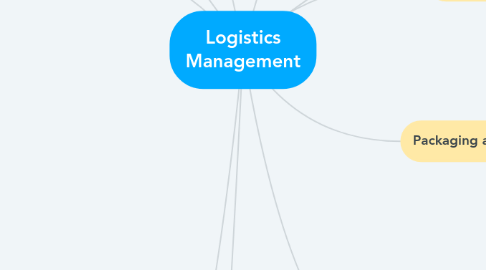
1. Inventory Management:
1.1. The basic objective of inventory management is to minimize the amount of working capital blocked in inventories.
1.2. Management has to maintain inventories of:
1.2.1. 1. Raw-materials and parts 2. Semi-finished goods 3. Finished goods
1.3. Anticipation Inventory
1.4. Safety Inventory
2. warehousing is that logistical activity which creates time utility by storing goods from the time of production till the time these are needed by ultimate consumers.
3. Procurement:
3.1. It is the timely supply at the lowest cost.
4. Warehouse:
4.1. Handling is essential to avoid damage and deterioration of materials, this helps to minimize costs and time.
4.1.1. Materials handling is divided into three categories:
4.2. must take into account
4.2.1. 1. The number and type of warehouses needed and
4.2.1.1. 2. The location of warehouses.
4.2.1.2. Storage Warehouse
4.2.1.2.1. Buffer Warehouse
4.3. Conveyors
4.3.1. Discontinuous Conveyors
4.3.1.1. 1. Manual lift truck
4.3.1.2. 2. Lift pallet truck
4.3.1.3. 3. Counterbalance forklift
4.3.1.4. 4. Reach truck
4.3.1.5. 5. Narrow aisle truck
4.3.1.6. 6. Stacker crane
4.3.1.7. 7. Automated Guided Vehicle (AGV)
4.3.2. Continuous Conveyors
4.3.2.1. 1. Roller conveyor
4.3.2.2. 2. Chain conveyor
4.3.2.3. 3. Belt conveyor
4.3.2.4. 4. Circular conveyor
4.3.2.5. 5. Electric pallet ground conveyor
4.4. Package
4.4.1. Disposable packaging
4.4.2. Reusable packaging
4.5. Storage
4.5.1. Static Storage System
4.5.1.1. 1. Block storage
4.5.1.2. 2. Pallet Rack
4.5.1.3. 3. Drive-in Rack and Drive-through Rack
4.5.1.4. 4. Bay Shelf
4.5.1.5. 5. Cantilever Shelf
4.5.2. Dynamic Storage System
4.5.2.1. 1. Live Storage Shelf
4.5.2.2. 2. Push-back Shelf
4.5.2.3. 3. Vertical carousel
4.5.2.4. 4. Horizontal carousel
4.5.2.5. 5. Slide shelves
4.6. Pallet/Loading Loading Units
5. Information
5.1. Business Information Characteristics
5.1.1. 1. Accessible
5.1.2. 2. Relevant
5.1.3. Accurate and Timely
5.1.4. Transferable
5.2. Information Characteristics
5.2.1. Speed
5.2.2. Variability
5.2.2.1. Speed
6. Types of Logistics:
6.1. Inbound Logistics- developing parts, components and subassemblies to factories for final assembly.
6.2. Outbound Logistics- the system that delivers finished goods to a customer.
6.3. Reverse Logistics- the process of moving products from the customer to the seller.
7. Network design is the efficiency of logistics that determines the number and location of manufacturing plants, warehouses, material handling equipment, etc.
8. Order Processing:
8.1. Order processing based on your receiving, handling, and filing activities must be accurate, reliable, and fast for best efficiency and customer satisfaction.
8.1.1. Improving Order Fulfillment - Order what you need - Know the seller - Study alternatives - Consider the environment
9. Packaging and Labeling:
9.1. Transportation is that logistical activity which creates place utility.
9.2. Packaging implies enclosing or encasing a product into suitable packets or containers, for easy and convenient handling of the product by both, the seller and specially the buyer.
10. Transportation:
10.1. Transportation is needed for:
10.1.1. 1. Movement of consumers.raw-materials from suppliers to the manufacturing unit. 2. Movement of work-in-progress within the plant. 3. Movement of finished goods from plant to the final
10.2. Major transportation systems are:
10.2.1. 1. Railways 2. Roadways 3. Airways 4. Waterways 5. Pipelines.
10.3. considerations:
10.3.1. 1. Speed of transportation system 2. Cost involved in transportation 3. Safety in transportation 4. Reliability of transportation time schedules 5. Number of locations served etc.
